ESPERANCE AIRFIELD AND
ESPERANCE BAY FLYING BOAT LANDING AREA
ESPERANCE, WA
IN AUSTRALIA DURING WWII
![]()
A Minute Paper signed by the Secretary of the Air Board dated 3 February 1939, confirmed that the Air Board considered a landing ground was necessary at Esperance for defence purposes, although it was not in a high order of priority. It was to be used as a refueling point and emergency landing ground for aircraft operating in the defence of trade and shipping in the Cape Leeuwin and South-western area. The Air Board intended to request the Civil Aviation Department to make provision in that Department's estimate for the year 1939/40, for the sum of money necessary to give the required assistance to the local Road Board to prepare the ground.
On 8 February 1940, Mr. A. B. Corbett, the Director-General of Civil Aviation advised the Secretary of the Department of Air at Victoria Barracks in Melbourne that the preparation of Esperance landing ground was 25% complete and final completion was expected at the end of the month. The men working on the new airfield camped at Gibson's Soak. The Kalgoorlie Miner newspaper reported on 20 December 1940 that "The necessary buildings for the new aerodrome are now being erected."
The airfield was located alongside the Esperance to Norseman Road and was about 12 miles by air from the town of Esperance. The following is a report from the final inspection of the airfield upon completion which was passed on to the Secretary of the Department of Air by the Director-General of Civil Aviation on 7 February 1941:-
"All works are complete at this Aerodrome, which was found to be in excellent condition. Some Christmas Tree and other suckers are showing on the landing areas, and the Dundas Road Board, who carried out the preparation, are being asked to remove these under their maintenance clause. The couch grass seed has shown excellent growth over the majority of the landing area, the only portion not so advanced being the South-western corner where the surface is more gravelly. Fencing, boundary marks, and circle are in order. Only one windsock is fitted, though two posts are provided. Inspector Hilgendorf will see that the windsock is fitted."
Another report by Inspector Hilgendorf dated 25 November 1942 read as follows:-
"This ground was inspected on the 13th November with Flt. Sgt. Roe, who is in charge of the RAAF personnel at this ground."
"The seed on this ground was apparently sown by drill although the specification called for broadcasting. The couch grass there has grown in the coulter rows but has not spread between these rows. Sand has blown up against the rows and as a result the surface is now corrugated when running across the rows."
"A suggested treatment for this, when the present fence obstructions are removed, would be harrowing across the drilling and then rolling. Grading would not be satisfactory as it would tear the grass about and cause further roughness."
"The wind indicators need replacing."
F/Lt A. Y. Montgomery visited Esperance Airfield in December 1943 and reported that three strips were cultivated, harrowed and graded on 1 August 1943 as follows:-
32º x 4500' x 150'
84º x 4200' x 150'
115º x 5000' x 150'
The Secretary of the Department of Air advised the Department of Civil Aviation on 12 July 1944 that Esperance Airfield was no longer required for RAAF purposes and it was proposed to hand it back to the Department of Civil Aviation.
Inspector Hilgendorf carried out another inspection on 11 May 1944 which read as follows:-
"This ground was inspected on 11.5.1944, and although three landing strips had been grassed by the RAAF, they were still very rough. A telegram to Divisional Works was accordingly despatched reading as follows:-
"Divisional Works, RAAF, Perth.
Esperance - understand grassing three strips
completed stop. Still very rough stop.
Suggest urgent harrowing and rolling four
strips before grass damage would result.
Hilgendor.""Flt/Lt Cowles of the Divisional Works, advises that this request was immediately passed to the Allied Works Council for action, as there were still funds available from the amount made available for the grassing of the area."
"No recent report from Airlines (W.A.) Ltd. had been received as to improvement or otherwise of the ground."
A joint inspection of the airfield by representatives of the Director of Works and Buildings, Air Force Headquarters, Victoria Barracks, and the Department of Civil Aviation and the Department of the Interior was carried out on 14 August 1944. The DCA representative expressed the opinion that the airfield would be quite satisfactory as soon as the rolling in progress at the date of inspection , was completed.
There may have been an RAAF HF/DF Station located at Esperance.
On 7 May 2020 Nicholas Kleinig sent me the following photos of what appears to be one of three proposed WWII machine gun emplacements located at the westernmost point of Esperance Airfield. There were no Australia Army units posted in the Esperance area during WWII so these guns were probably manned by RAAF personnel for the Operational Base Unit members based at the airfield. On that basis the machine guns were most likely to be Bren guns which were used by the RAAF.
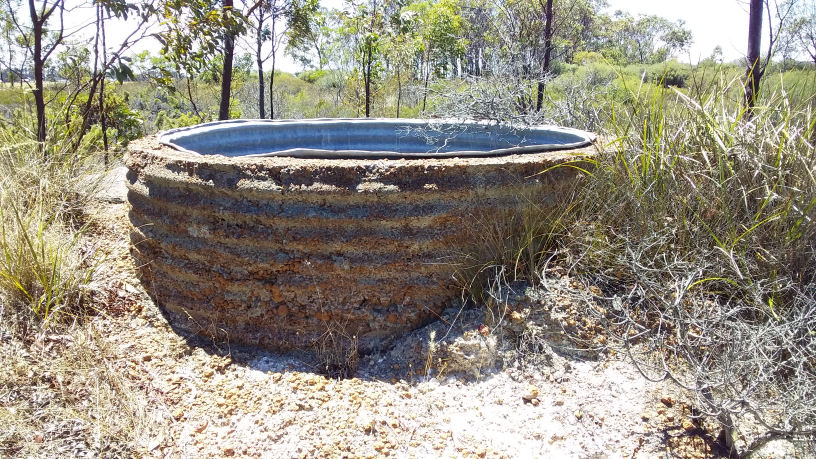
Photo:- Nicholas Kleinig 2020
What appears to be a machine gun
emplacement
built using a concrete coated water tank.
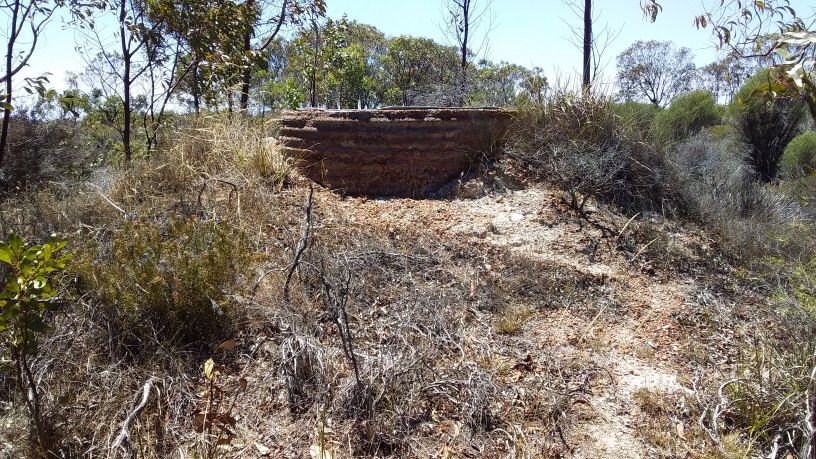
Photo:- Nicholas Kleinig 2020
Different view of the machine gun emplacement at Esperance Airfield
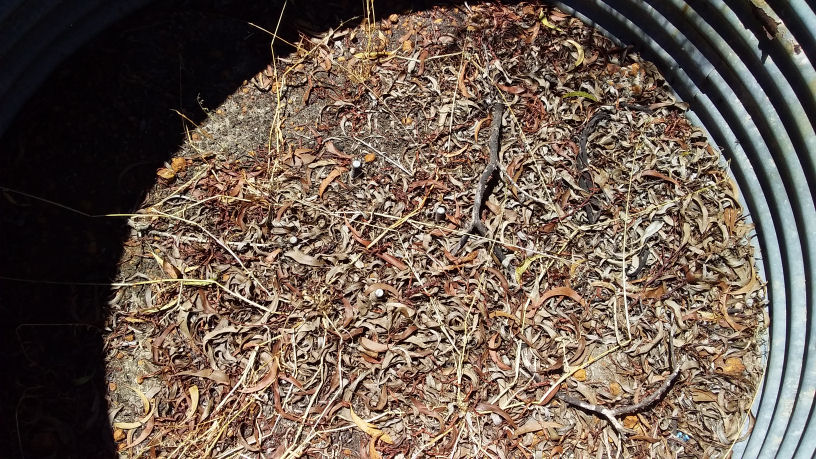
Photo:- Nicholas Kleinig 2020
If you squint you can see four bolts arranged in a square layout to mount a machine gun
On 12 May 2020, Nicholas Kleinig cleared some scrub off one side of the above gun emplacement to reveal a set of concrete stairs. See the photos below.
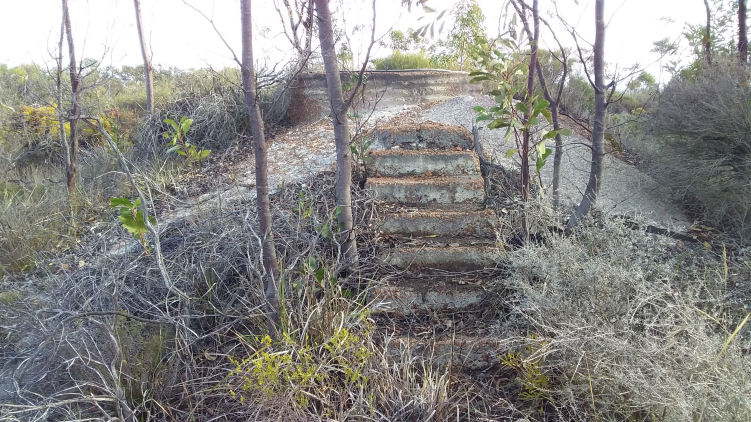
Photo:- Nicholas Kleinig 2020
Concrete stairs revealed after clearing away some scrub
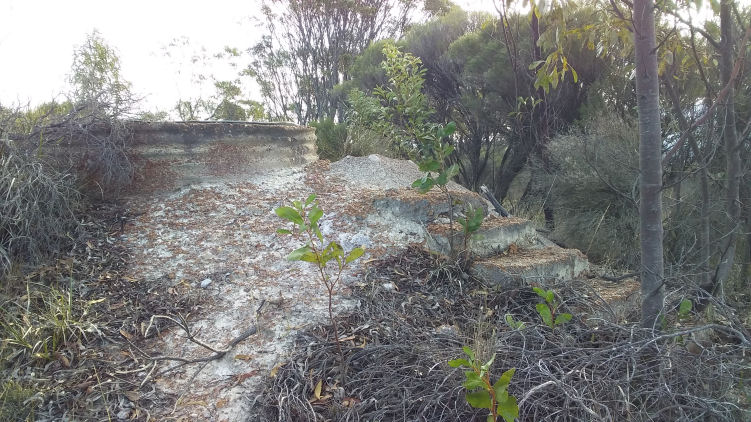
Photo:- Nicholas Kleinig 2020
Another view of the concrete stairs
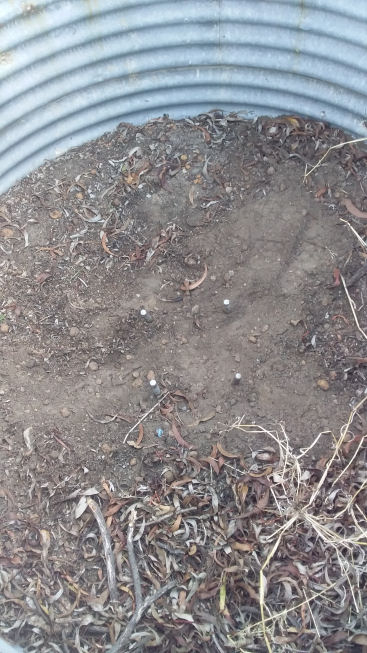
Photo:- Nicholas Kleinig 2020
The four bolts in the middle of the gun emplacement
Nicholas Kleinig discovered another machine gun emplacement at the southern end of the airfield on 12 May 2020. It took a bit of chainsaw work to expose it to be able to take the following photos.
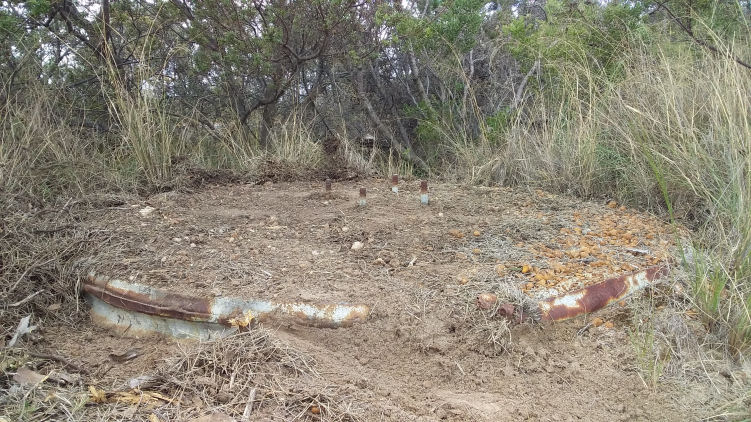
Photo:- Nicholas Kleinig 2020
A second gun pit located at the
southern end of the airfield.
Four mounting bolts can be seen in the middle of the pit.
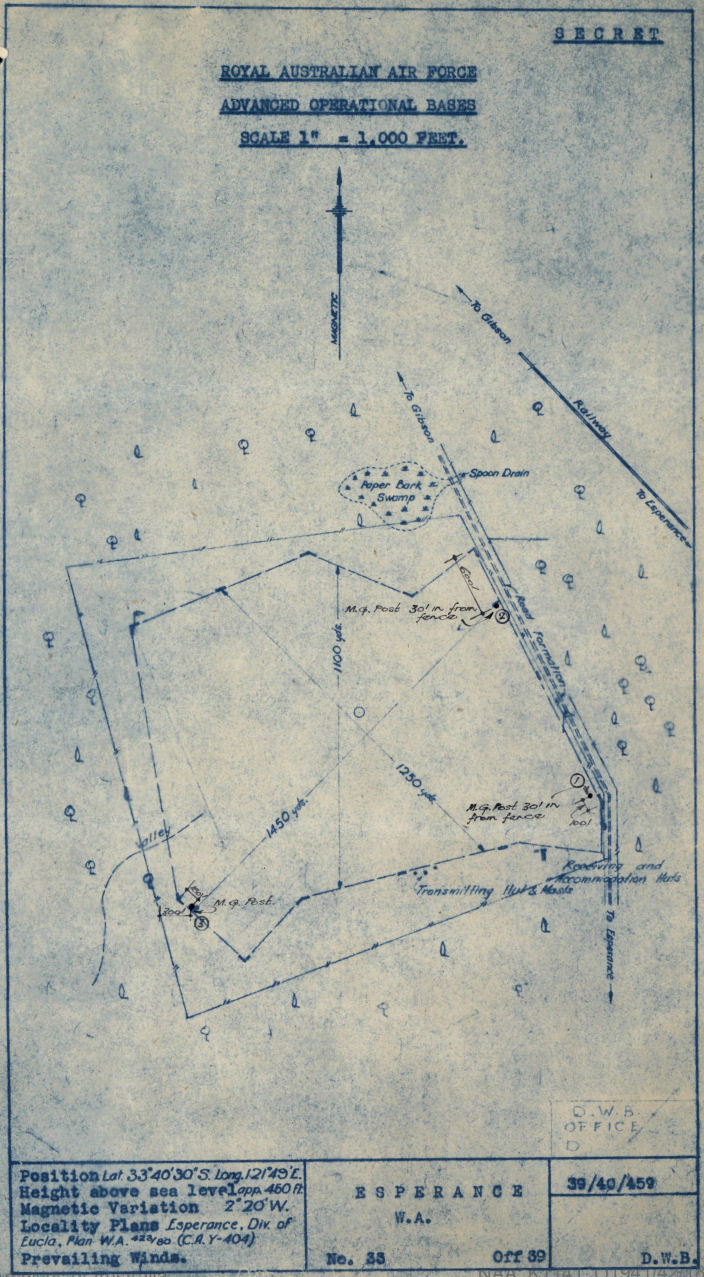
Plan:- NAA File
The above plan shows the location of the 3 machine gun posts.
The above plan itself is a copy of one from 1939/40 as dated, but the gun posts were not put in until 1942. From what Nicholas has read in the National Archives, the northernmost of the three machine gun emplacements may not have gone ahead.
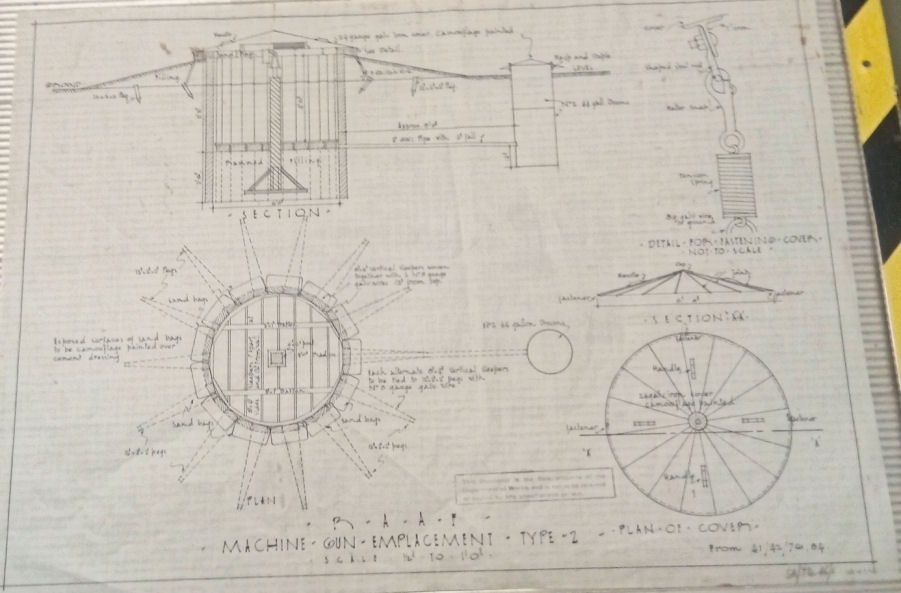
A low quality copy of a drawing of a Type 2 Machine Gun Emplacement
Reading through that same sanitation file, Nicholas found that the machine gun posts were to be built as shown on RAAF plan 41/42/76 and 41/42/84A - the plan attached shows 76 and 84, not 84A, so similar to what exists but not exactly what was constructed. Nicholas believe standard drawings for each RAAF machine gun emplacement type used in Australia will be in here, though still waiting on a response from the National Archives on this one.
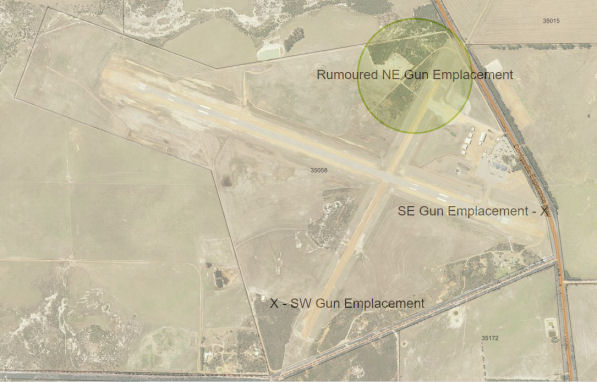
Locations of gun emplacements
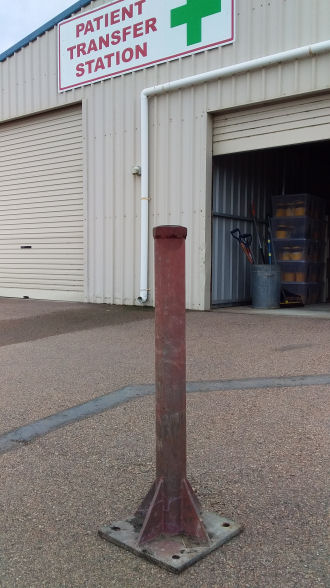
Photo:- Nicholas Kleinig 2020
Modified machine gun stand handed over to
Nicholas Kleinig on
25 May 2020 by long time neighbour of the airfield, Ken Crawford
The machine gun mount in the above photo was modified by Ken Crawford by cutting the top off years ago to use the base as a table in his cattle yards. Ken said that the stand once stood at eye-height within the ‘staircase’ gun emplacement, and it had what Ken described as an ‘axle’ mounted on the top to allow 360 degree pivoting. Ken’s kids - all very grown up now - used to play with the mount in that emplacement before the aviation world changed and fences went up around the airfield.
Kathy Hine told me in April 2018 that the museum in Esperance has an engine on display from a Catalina flying boat. An old timer in town claimed that during WWII, the Americans brought Catalinas here (they did, see below), and were billetted out in the town, and also took over the local turf club as their camp. Another source claims it was in the 1950's and not during WWII at all. Kathy also advised that a couple of years earlier, in the vicinity of what was the turf club in the 1940's, someone had found a pile (not sure how many) of army helmets.
The War Diary for Deputy Commander Fleet Air Wing Ten, dated 29 October 1943 shows that three Catalinas from VP-33 that were enroute from Adelaide to Advance Base Able at Pelican Point in Perth, WA (Crawley), landed at Esperance Bay in WA and remained overnight before proceeding on their way. Another entry dated 30 October 1943 noted three Catalinas from VP-33 landing at Esperance Bay.
The War Diary Patrol Squadron Thirty-Three VP-33 for 28 October 1943 showed "3 planes, extended flight, Adelaide to Esperance". The entry for 29 October 1943 showed "3 planes, extended flight, Esperance to Perth." These entries relate to the flights detailed in the previous paragraph.
The War Diary for Deputy Commander Fleet Air Wing Ten, dated 2 June 1944 showed one Catalina flying from Esperance to Perth. An entry on 3 June 1944 shows one R4D-3 flying from Perth to Esperance Airfield and returning to Perth on the same day.
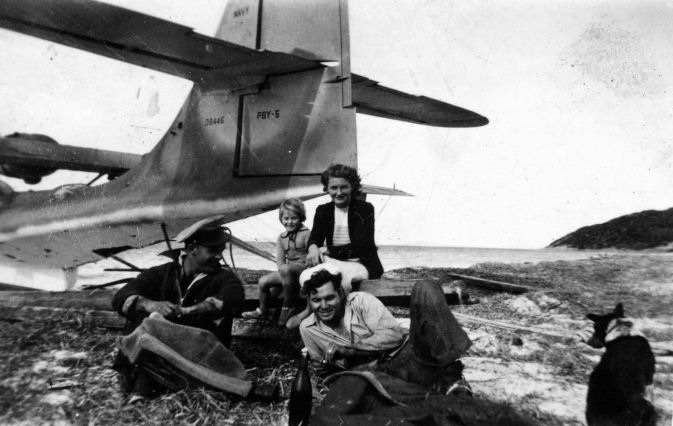
Photo:- via Nicholas Kleinig
US Navy PBY-5 Catalina Bu. No. 08446 in Esperance Bay during WWII
The Coastal Radio Service commissioned radio station VIE at Esperance in Western Australia on 21 July 1913. At the outbreak of WWII on 3 September 1939 the operations of the Coastal and Island Radio Services came under the control of the Royal Australian Navy whilst AWA retained ownership and its management role of the network. Existing staff continued to be paid by AWA. Military Guards were placed at all Radio Stations.
REFERENCE BOOKS
Fold 3 - War Diary for Deputy Commander Fleet Air Wing Ten
Fold 3 - War Diary Patrol Squadron Thirty-Three
ACKNOWLEDGEMENTS
I'd like to thank Graham McKenzie-Smith, Kathy Hine and Nicholas Kleinig for their assistance with this web page.
Can anyone help me with more information?
"Australia @ War" WWII Research Products
|
© Peter Dunn 2015 |
Please
e-mail me |
This page first produced 10 May 2020
This page last updated 17 September 2020